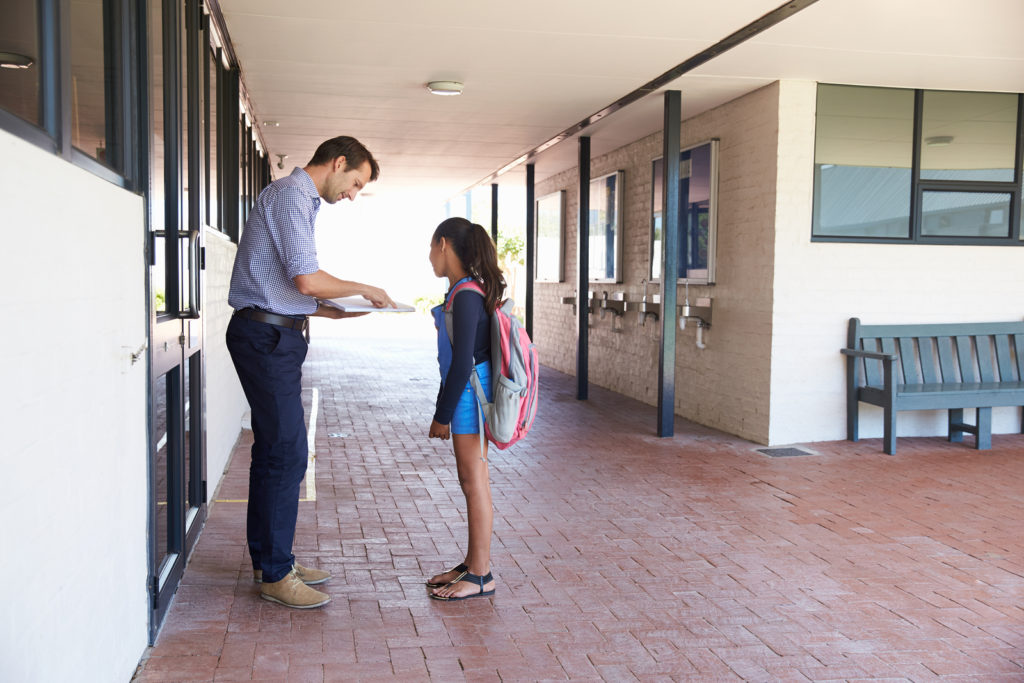6 Questions to Tackle in Being Exemplary When Communicating with Students
11/27/2017

Actions speak louder than words! To connect with our students we must think about the words and the actions we take in and out of the classroom. One of the first education books I read was Harry Wong's 1997 book titled, The First Days of School: How to Be an Effective Teacher. The accompanying videos brought Harry right into your living room. They created a classroom on stage that was similar to a late 1990's classroom. He then modeled what he was talking about…which was the next best thing then actually seeing Harry in real life. I saw what it looked like and sounded like to be an effective teacher….my career started in 1998…perfect timing!
One thing that really stood out in the videos and his book was communication. One of the strategies he is most known for is what I call the "doorway strategy." Harry would stand at the door and greet every student that came into his classroom. This personalized greeting made each student feel cared for and respected. He modeled how we must take time to connect individually with every student that walks into our classroom. As I started to use this strategy from my first day of teaching, I realized how powerful it was in getting to know the students. It was my thermometer and barometer.
The thermometer check (hot or cold temperature) was one of my greatest tools for individual students. I would make sure to connect and add specific praise and generalized positive comments, especially with the students that needed it the most. Every student received a comment, question, or a positive. I knew I had better check in before instruction started with specific students that I knew came from trauma, anxiety, or struggled with behavior. I would build the proverbial bank account in order to be able to deposit, and more importantly, to withdraw from the bank account when something needed to change.
The doorway strategy also gave me a barometer check for the overall feeling (or barometric pressure) of the class. I quickly would adjust in my mind what I had planned for during the instructional day. If students came in overly talkative, I knew I had better plan for more "active participation" or "learning structures." If I had to deal with behavior problems that occurred before school even started, I knew I had better start with a class meeting, or some calming activity to lower the anxiety. Likewise, if students came in relatively happy and positive, I knew I could start with difficult learning tasks.
The ability to be flexible comes from communication. We must master the ability to communicate effectively from listening and reading our students, then choosing the correct words and actions (or non-actions). The old adage, "People don't care how much you know, until you show them how much you care," is very true in the education setting. Many teachers start with the most difficult curriculum right away in the morning without a thermometer or barometer check…they do not care….they have a district mandated pacing guide and they feel the need to meet those expectations above everything else!
Being an exemplary communicator is much more than how well we relay content to our students, it is about reading our students, and being flexible to refine our expectations immediately. The clarity of our learning goals, the ability for students to follow directions, and the ability for a student to connect to prior learning through our words and activities we chose are the primary elements in Charlotte Danielson's Evaluation Model, Communicating with Students.
Here are six questions that will support your transition from a proficient to exemplary teacher in this domain.
1 - How Well Do You Create Relationships with Students, and Do You and Your Students Contribute to the Classroom and School Culture?
Communication begins with the ability to create trust. Trust between the teacher and the student is the foundation created from the first day of school, and many master teachers start even before this. These master teachers connect with students through summer letters or even learn their names in the hallways before they even attend the class.
Trust is give and take; those teachers that earn respect as compared to commanding respect are more revered. Listening, researching, and learning more about our students are a few strategies that can support communication. When we spend time listening to learn, and not speaking to be heard, students learn fast that this teacher cares about me, as well as my likes and dislikes. A teacher can then use that information to continue to connect with individual students. Asking about hobbies, movies, family, sports, and music are all great topics to use when communicating with students. Many educators stay up on the latest information from these areas, as they are easy conversation starts, even when they do not prefer the topic. Teachers do this in order to connect and create genuine trusting relationships.
Some teachers have one group of students for over 1000+ instructional hours a year and they get quite close with students and their families. Then there are teachers who have 200+ students for less than 180 hours of instruction a year. Inherently, the middle school and high school teachers have a more difficult task in creating strong relationships due to the lack of time with students as compared to their elementary partners. Tips, tricks, and strategies should be shared among teachers especially when connecting with behaviorally challenged students, introverted students, or students who are ridiculed for their beliefs and even bullied.
The effectiveness of a teacher in creating strong relationships is proportional to how students treat each other. The teacher models language, actions, and allows and permits conversations that are positive and proactive. The teacher ultimately creates the classroom culture. How the students treat the teacher, as well as how they treat each other, is important to the communication process.
A developing teacher does not worry about the classroom culture. They begin class when the bell rings by opening a book, turning to the next page, reading the content, assigning a task, and then proceed to sit at their desk not feeling a need to further support students. Technically, this teacher is following the district curriculum, "teaching" the content, and assigning a "task." How well a student does in this developing or unsatisfactory teacher's environment is unpredictable.
An exemplary teacher greets students at the door, connects with almost all students as they enter, and creates a culture of learning. The teacher adjusts curriculum, instruction, and even assessment delivery based on what the students give him or her that day as they walk into the classroom. The teacher communicates exactly what they will be doing for the period, how they will be assessed, what they will know by end of the lesson. The teacher then engages students in the content, discusses misconceptions, continually checks for understanding using questions and discussion, allows for students to create questions that take the concept further, allows for partner or group discussion, allows for self-reflection and self-assessment, and assigns a task or assignment. At the end of the lesson, the teacher gathers feedback: the teacher summarizes what they have learned, what they should be able to do because the new information they garnered, and gives a quick formative or summative assessment to determine how well the students met the learning objective. Students contribute to the feedback through self-assessment. This data is used to determine the next instructional decisions, as well as individual needs. This cycle is repeated with some variation each and every day. The teacher builds on prior learning, and the students know where they are going with instructional goals. The culture of learning is visible and communicated to students daily.
The exemplary teacher also plays a role in developing, sustaining, and changing the culture of the school. Though the principal and leadership of the school drive the overall culture, an exemplary teacher and his or her students can help change a negative culture. They can also raise the level of positive culture in a school by developing and implementing ideas that celebrate and extend student opportunities for success. A developing or unsatisfactory teacher creates a counter-culture that can break down a school's overall positive culture. This can be a vindictive plight formulated by the teacher or it can even be done without the teacher understanding it is occurring. It is the leadership and the teacher-leaders that take this counter-culture on positively!

For example, when a successful school is having trouble with the hallways, the leadership or teacher-leaders can implement a positive praise system. Instead of teachers going after each other negatively with rumors or other passive aggressive acts, starting the Golden Soul Award might be a positive spin for a solution. When you dig into the hallway problem you find that there many small things not being done by most teachers: teachers dropping off or picking up their students late, teachers not proactively teaching hallway expectations, teachers not visible in the hallways, and teachers not supporting one and another's students in the hallway. The Golden Soul Award (idea from Tammy Good @TCGood1) is a spray-painted shoe that is given to a classroom, or grade level, that exemplifies what it looks like and sounds like in the hallway: 1) appropriate voice level, 2) everyone safely travels throughout the hallway, 3) teachers pick up/drop off students on time, and 4) teachers celebrate their students and other students doing their job. A small number of Golden Souls can be given out according to grade levels, parts of the building, teams, etc… Each week the awards are given to classrooms by an anonymous staff member. Teachers and students do not know who the person giving the award. After a class, or grade level, has received the Golden Soul Award, a picture of a Golden Soul is put in their room. The purpose is to empower the students and teachers to do the correct thing.
2 - How Well Do You Know Your Content and Well Can You Communicate What You Know?
Once a teacher has built trust with their students, getting them to follow directions the first time becomes second nature. Students understand that you are only going to give directions once. Their respect and revere for the teacher is evident by watching them listen. Likewise, students understand, follow, and help refine the routines and procedures of the classroom. When you visit a classroom where these ideals are present one would say the class could run itself. Nothing is more evident as when there is a guest teacher in the classroom. Everyone understands their job and supports the guest teacher in having a pleasant and well-organized time in the classroom.
Master teachers understand the importance of giving directions that are clearly stated, age-appropriate, and have a real-world purpose or rationale. They give directions one time and the students understand and are able to complete the task with a high level of completion. There are many strategies a teacher can use in order to get students to follow directions the first time given. One strategy is a simple "repeat and reteach a peer" strategy. The teacher gives a direction and then has the students repeat it whole class. Lastly, the teacher has them pair share why they are completing the task. The students get the same direction three times, as well as rationale in student language from a peer. If done correctly, this strategy can support your students completing a task with the teacher only stating the directions once.
Exemplary teachers spend an abundance of time teaching routines and procedures. These teachers can give a simple direction to get a Chromebook, and all students will be able to be on their computer in under two minutes. For example, "One's, you may get your Chromebooks. Go!" From a simple observer, you would never know how much time and practice the teacher and students have put into doing this routine. The class is broken into four groups, one to four. In a class of twenty-eight, seven students may pop up from their desk to get a Chromebook. They walk over to the Chromebook cart, take their turn in getting the designated Chromebook out of the cart. Students have been taught how to unplug it from the cart, grab it with two hands, and carry it successfully back to their desk area. This is all timed and done in under 30 seconds. Students practice this and set goals. Students know to start the Chromebook right away and wait for the next direction. Then, "two's" would then pop up out their desk and do the same routine. All students will be at their desk in under two minutes with a Chromebook and ready for the next direction.
The unsatisfactory and developing teacher does not have a set routine. Students jostle for position, even push to get their way. Chromebook security is in jeopardy, and there may even be Chromebooks that have been dropped or marked up. Students may not have their Chromebooks on and they are not ready to begin instruction in under five minutes. Exemplary teachers have several routines and procedures where one word or one sentence puts in play a plethora of practiced tasks. Students even play a role in discussing and deciding how directions, routines, and procedures could be even more efficient and effective.
3 - Do You Know Your Content So You Can Proactively Communicate and Remediate the Possible Areas for Misunderstanding?
First year teachers are at a disadvantage with curriculum. As they learning and understanding what they are supposed to teach as well as how it builds on prior learning, they also must start deciding on how the content can be taught to the specific students seated in front of them. The proverbial laminated lesson plan from the years before should be a joke of the past. Each class is different from the last set of students. Yet, as you gain more teaching experience, you start to learn about the difficulties most students have with the curriculum you are teaching, as well as the difficulties of specific students in the class.
As you transition from a developing teacher to a proficient teacher, you will learn about the strengths and weaknesses of the curriculum that you are required to teach. In addition, you will find the holes in the curriculum; no curriculum covers all the state standards you are required to teach. Though a few textbook companies advertise that cover all Common Core Standards, your state may have additional standards that are required. Know your state's standards first, and then know your school district's curriculum.
As you transition from proficient to exemplary, you will learn how to add in other curriculum to fill the holes of both the district curriculum and the state standards. You may even find better materials that meet the needs of the students in your classroom. Make sure you are always communicating with your grade level team, vertical team members, as well as your administration when you veer away from the required curriculum components. Again, this may be necessary to meet the specific needs of the students in the classroom.
Exemplary teachers connect to prior learning, or schemata. First coined by Jean Paiget, schemata is from the constructivist theory of learning where students learn best through scaffolding the concepts introduced. These teachers link the lesson's instructional purpose or rationale to the larger curriculum. The teacher is very thorough with teaching the content, using precise vocabulary, and scaffolds the information. Exemplary teachers also connect many of the learner objectives to student's interests. In this fashion, the student engagement is increased.
Students are allowed, even encouraged to ask questions, provide their input on the topic, as well as opportunities to teach other students the content. Exemplary teachers understand the highest level of understanding is the ability to teach someone else. If asked by an observer, or the teacher, students are able to explain what they are learning and how it fits into the curriculum overall.

4 - Do You Know Your Content So You Can Proactively Communicate and Remediate the Possible Areas for Misunderstanding?
New teachers can be at a disadvantage when teaching the curriculum, especially with the common misunderstandings or misconceptions students will have with the content. New teachers can research, learn as much as they can about their students, and team with colleagues to address these misunderstandings as they arise. Unfortunately, much of the learning in this area comes from experience in the classroom. Individual students will have misconceptions that may not be evident with the rest of the class. Communication plays a vital role in changing these misunderstandings.
Exemplary teachers find out which specific students have misunderstandings of the curriculum. They ensure that students change their thinking and reconfirm their misconceptions have been changed through discussion, instruction, and assessment. These teachers have students discuss the questions pertaining to the content more than the time allotted for direct instruction from the teacher…in essence, more student-talk than teacher-talk! The teacher knows that this discussion can be powerful, and they must spend time listening, coaching, and reframing vocabulary and thinking.
5 - What Role Does Vocabulary Development Play in Instruction, as Well as with Student's Generalized Vocabulary?
The words teachers use are the magic that can support student learning. The art of choosing the right words at the correct time comes from experience with students, as well as knowing and understanding the curriculum masterfully. Using precise vocabulary supports students learning and helps them connect to prior learning.
Development of academic vocabulary has been researched extensively as of recent by many education gurus. They are studying the amount of vocabulary, as well as the precise vocabulary, necessary at different age levels in order to be successful. Robert Marzano has done extensive research on academic vocabulary. He gives a six-step strategy when learning vocabulary in an article titled, "The Art and Science of Teaching / Six Steps to Better Vocabulary Instruction,"
- Provide a description, explanation, or example of the new term.
- Ask students to restate the description, explanation, or example in their own words.
- Ask students to construct a picture, pictograph, or symbolic representation of the term.
- Engage students periodically in activities that help them add to their knowledge of the terms in their vocabulary notebooks.
- Periodically ask students to discuss the terms with one another.
- Involve students periodically in games that enable them to play with terms.
An exemplary teacher also works on a student's general vocabulary through discussion, modeling, and casual conversations. They understand that there are different registers of vocabulary and conversation. A teacher conveys that vocabulary and conversations are different from you are at school as compared to when you are at home. Students talk different with friends then when they talk with adults. A student's ability to understand what register they should be in will support their job employment, as well as with other relationships. Ruby Payne talks about this change in vocabulary register in her work titled, "Understanding and Working with Students and Adults from Poverty."
Master teachers are also challenging the thinking of their students by increasing their precise knowledge of the discipline, as well as their generalized vocabulary in multiple fashions. One strategy they use is rich language with brief lessons when appropriate. They use imaginative language full of metaphors and analogies. Rick Wormeli provides great strategies across disciplines in his book titled, "Metaphors Analogies: Power Tools for Teaching Any Subject." He states that metaphors and analogies are
"…"power tools" that can electrify learning in every subject and at all grade levels. Metaphors show students how to make connections between the concrete and the abstract, prior knowledge and unfamiliar concepts, and language and image."
Two learning structures that stand out in exemplary teacher's classrooms are the use of inquiry-based learning and Socratic methods. They are powerful tools in a vocabulary rich learning environment. Though these are not prerequisites to moving from proficient to exemplary in Charlotte Danielson's Evaluation Model, they are strategies that make exemplary teachers stand out when implemented well. The depth of conversations, self-reflection, and curiosity automatically increase engagement.
- Inquiry-Based Learning - The 5 E's
- Engage
- Explore
- Explain
- Elaborate
- Evaluate
- Socratic Learning Method
The true test is sitting in a classroom and listening to the conversations between students. Not only listening to their academic vocabulary, but their general conversations. The teacher is the conversation leader and what he or she permits, is allowed in these conversations. An observer can learn a lot about both the students and the teacher through observation.

6 - What Role Do Students Play in Supporting Learning Through Their Communication?
Empowering students to take a major role in communication, and their own learning is a teacher's goal. If we can step aside and facilitate learning rather than being the sage on the stage, we have done our job. Agency is the ability for students to take ownership of their learning progression. We can build agency through effective communication and handing over many of the procedures, routines, and curriculum instruction to students. The teacher does not just hand over all components of the classroom to students, but uses a gradual release of responsibility. When students are ready, they are given the opportunity to prove they can handle each component. It may take the whole school year, but the teacher's goal is always to transfer the power back to students.
There are number of strategies that support student-led conversations in instruction. Kagan Learning structures empower students and use the gradual release of responsibility (read my past blog: 5 Questions to Tackle in Organizing the Physical Space of the Classroom). Another strategy teachers can use is having students supporting each other academically before coming to the teacher. The strategy called "Three Before Me," allows students to talk to three different students before coming to the teacher. This allows teachers to spend more time with students that need support, and allows students who many need a little support to get it right away. The teacher has to monitor this strategy, as there is always re-teaching that needs to take place, as well as refining associated procedures and routines.
Another academic strategy is the use of student mentors. Partnering a student who is proficient in an area with a student that needs more support can be powerful. Students teaching other students concepts in "kid language" can be the trick sometimes when a teacher has used several different instructional methods already.
The use of technology has changed this domain in the past few years. The use of social media and Web 2.0 tools has been evident in many classrooms. One such elementary classroom uses the Seesaw application. This is an online portfolio. Students must defend why they put each artifact in their portfolio with the teacher, as well as their parents who have access at home. Screencastify is another powerful tool that teachers can use to support students. Teacher can create tutorials, direction instruction segments, and even have students create their own Screencastify that can be viewed by other students. The transfer of who provides the content is powerful when students are given this role. Technology has made student communication limitless.
MORE ROCK MY EVALUATION RELATED READINGS:
- Being Exemplary When Communicating with Students (Currently here)
- Using Questioning and Discussion Techniques
- Engaging Students in Learning
- Using Assessment in Instruction
- Demonstrating Flexibility and Responsiveness in the Classroom
- Learning How to Say No and Set Boundaries with Parents - November 21, 2022
- If You Had Only One Behavior Strategy to Use in Your Classroom, What Would It Be? - September 26, 2022
- Live Your Code: 7 Strategies That Will Help You Be the Most Effective Educator You Can Be - August 15, 2022










